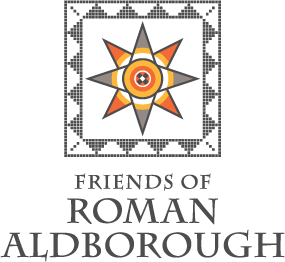 A Brief Overview
A Brief Overview
The Roman name for Aldborough was Isurium Brigantum
The town was established sometime after AD74 when the Romans established themselves in Northern Britain, following an uprising by the Brigantes tribe. The Brigantes were the native people who ruled most of what is now Northern England from the area of Hadrian’s Wall down to South Derbyshire.
The origins of Isurium are not fully understood. In 1993 the Highways Agency started on works to upgrade the A1 just to the west of Boroughbridge. Archaeological surveys and investigations identified the site of a Roman fort just to the west of the present route of the A1, on the banks of the River Ure near the village of Roecliffe. This fort has been dated to the Flavian period (69 – 96 A.D.) It was probably built early in that period and there is no evidence of occupation into the second century.
By the end of the Flavian period, Dere Street had been constructed between York and Corbridge which is close to Hadrian’s Wall. The B6265 follows the track of Dere Street and heads north from Green Hammerton towards the modern town of Aldborough. Dere Street would have crossed the Ure in the vicinity of Isurium roughly a mile further East from Roecliffe. One possibility is that the Roman town of Isurium started as a trading community bringing goods from the river to Roecliffe and continued after Roecliffe became redundant.
Roman Britain was divided into a number of civilian administrative areas each governed from a ‘Civitas’. Isurium became one of these important centres in Britain. Unlike Eboracum, the Modern City of York, Isurium was not a military head-quarters but a civilian town surrounded by defensive walls and a ditch, with many high status town houses.
After the Romans left late in the 4th Century little is known of its history, although a medieval writer, Ranulfus Higden suggested it was sacked by the Vikings in AD 870. The same writer described Aldborough as one of the great English cities built by the Britons in Roman times. As a 14th century monk, he seems not to have approved much of the pagan Romans, hence the reference to Isurium being built by the British. What is significant is that Isurium (Aldborough) was recognised as one of the great towns alongside Chester, York, Edinburgh and Carlisle.
After the Norman conquest, towards the end of the 11th Century, the crossing of the Ure was moved upriver and a new town started to grow and became Boroughbridge. The old town assumed the name of Aldborough (Old Borough).
It eventually became a rural village with only traces left of its Roman past which we know today.
Writers in the 18th century refer to Aldborough and its Roman remains including pavements (mosaic floors). It was not until the 19th century that the real importance of such finds became widely recognised. A definitive book, Reliquiae Isurianae, was published in 1852 describing the known finds and the layout of the Roman town. In 1863 the museum was established in the grounds of Aldborough Manor to preserve many of the artifacts.
During the last 150 years, there have been a number of archaeological investigations around the town. The most recent is the on-going geophysical survey conducted by Cambridge University. Amongst the results so far, is confirmation that there is the site of a Roman amphitheatre adjacent to the town as suspected back in the 19th century.
